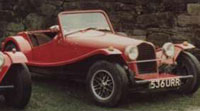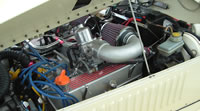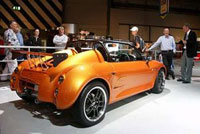Club History
The Marlin Owner’s Club was formally established in 1981 with a membership of 80.The members were people sharing an enthusiasm for the Triumph based, 2-seater Marlin Roadster (now referred to as Mark I cars). In 1983/84, the Marina based Roadster appeared (the Mark II) as well as a few hybrid cars (Triumph front suspension, Marina back end) and membership grew steadily. With the membership now approaching 400 people, in 1988 a full committee of seven members was set up and a club constitution agreed. Soon the membership was up to 500 and the club was being recognised as one of the UK’s leading owners clubs.
The Owners Club welcomes owners of any Marlin cars and their derivatives, and maintains cordial relationships with the production companies.
Brief History of the Marlin
The Marlin story started with a couple of traditionally styled open two-seaters built as “one-offs” by Paul Moorhouse, then a talented engineer working for Rolls Royce. Paul was then encouraged by friends to put the idea into production. When Paul first went public with the Alfa Romeo style inspired Marlin in 1979, one of the prototypes (566 URR), had served 5 years as Paul’s every day regular transport. This car was used in the original photo shoot and adverts.
 The car was light and nimble with clever designs to maximise the use of running gear from any Herald, Vitesse, Spitfire, GT6 or even Bond Equipe. It featured an innovative rollover bar integrated with the windscreen frame that was mated to a purpose built chassis. This chassis even catered for the Rotoflex rear suspension from later Vitesse’s and GT6’s by virtue of additional drillings in the chassis box sections. The Marlin was in contrast to other similar kit cars of the time such as Gentry and Spartan, which retained the donor’s usually rusty chassis.
The car was light and nimble with clever designs to maximise the use of running gear from any Herald, Vitesse, Spitfire, GT6 or even Bond Equipe. It featured an innovative rollover bar integrated with the windscreen frame that was mated to a purpose built chassis. This chassis even catered for the Rotoflex rear suspension from later Vitesse’s and GT6’s by virtue of additional drillings in the chassis box sections. The Marlin was in contrast to other similar kit cars of the time such as Gentry and Spartan, which retained the donor’s usually rusty chassis.
The first chassis was laid down on 1st July 1979 and sold to a Simon Lister for the princely sum of £655 inc VAT.
Mark 1s
Generically known as Mark 1’s, the all Triumph based cars had subtle changes in body and chassis design from the prototype.
 According to Paul Moorhouse’s notebook of the time, the generic Mark 1 all Triumph kit was divided somewhat confusingly, into three types listed as:
According to Paul Moorhouse’s notebook of the time, the generic Mark 1 all Triumph kit was divided somewhat confusingly, into three types listed as:
• MK 1’s – Chassis numbers 1001 to 1033*
• Mk 2’s – Chassis numbers 1034 to 1057
• MK 3’s – Chassis numbers 1058 to 1285
*Doors were an option from quite early on and don’t give an indication of age, as some late cars had none.
The last Triumph based car (chassis 1285) was produced in June 1983. Of the 236 all -Triumph-Herald kits produced approximately 160 are known to have been put on the road. Information on some of these cars is very sketchy indeed and doesn’t allow for re-registration of more than a couple of cars
Mark 2s
From 1981 the Mk2’s – Chassis number 2151 onwards, were being manufactured with the Morris Marina and later Morris Ital as a donor vehicle. During the two year transition period, till 1983, because the Triumph front suspension was always well regarded by engineers, Paul Moorhouse also built Hybrid kits using Triumph front suspension and Marina rear axle.
It is not possible to pick these cars out from the records as these Hybrids used the MK II prefix along with the completely Marina based kits.

The Marlin Roadster was a particular favourite for use in Classic Trials. It’s weight distribution and short wheelbase allowing it to travel over muddy lanes and rocky tracks better than less advanced designs. Many cars with Triumph and Marina running gear are still competing.
Over the years, various engines have been used from the original Triumph 4 and 6 cylinder engines, Ford Kent and Pinto and Zetec engines, various Italian twin cams and even the Rover V8. This all made for varied and exciting motoring and was a particular favourite with the trials brigade. Its weight-distribution and short wheelbase allowing it to travel over muddy lanes and rocky tracks better than less advanced designs.
Berlinetta
 Of those who had bought Roadsters originally, some now wanted more room for offspring and partners who also wanted to enjoy the fun of the Marlin. So 1985 saw the introduction of the Ford Cortina (later, Sierra) based Berlinetta. This came complete with previously unheard of luxuries such as wind-up windows, a lockable boot and a hardtop option. A touring car rather than a sports car, sales of the car were fewer than the Roadster, mainly due to the more limited market for such a car therefore in 1991, another design, the Cabrio emerged.
Of those who had bought Roadsters originally, some now wanted more room for offspring and partners who also wanted to enjoy the fun of the Marlin. So 1985 saw the introduction of the Ford Cortina (later, Sierra) based Berlinetta. This came complete with previously unheard of luxuries such as wind-up windows, a lockable boot and a hardtop option. A touring car rather than a sports car, sales of the car were fewer than the Roadster, mainly due to the more limited market for such a car therefore in 1991, another design, the Cabrio emerged.
Cabrio
Still very much a Marlin in looks, it sported more up to date mechanicals usually supplied by the Ford Sierra. This time, the car took all the fun of the Roadster but with more modern suspension and power. Inspired by Vanden Plas and featuring an advanced construction, this was the posh Roadster.
The YKC Cars
 In 1993 the production of the Roadster and Berlinetta models were sold to YKC Engineering in Yorkshire. As well as improving the roadster under pining by using Sierra suspension also YKC added the Raider, Mille Miglia, Julietta, Romero and Imola body variants to their line-up, which although bang up to date mechanically (and SVA compliant) retained many styling features familiar to Roadster owners.
In 1993 the production of the Roadster and Berlinetta models were sold to YKC Engineering in Yorkshire. As well as improving the roadster under pining by using Sierra suspension also YKC added the Raider, Mille Miglia, Julietta, Romero and Imola body variants to their line-up, which although bang up to date mechanically (and SVA compliant) retained many styling features familiar to Roadster owners.
Hunter and Sportster
Later, Marlin was bought by Terry and Mark Matthews who, as the new owners of the remaining Marlin marque, introduced the Hunter. Using the Cabrio as its base, the Hunter was a factory built car featuring a high quality of assembly but allowed customers to request features to make their chosen Hunter unique.
In 1997, in response to a demand for the Lotus 7 mould, Marlin added the Sporster model to their range. With more room inside, good weather equipment, doors and boot space, the Sportster was welcomed and continues to be in high demand as a kit car.
In 2002, to mark their 20 year history of car manufacture, Marlin developed the impressive limited edition BMW based Makaira.
5EXi
2004 showed yet another Marlin design, the Kool Kars 5Exi. Designed around the Rover K-Series engine/gearbox unit, this car offers a low-cost, easy-build with modern styling and practical features that make it great fun to drive. Sales of the kit have taken off and a Racing Club has been formed for owners of the later and current versions of Marlin cars.
 In 2006 Don Burt of YKC retired and sold the car ranges to Aquila sports cars Ltd. Run by Milan Mladenovic, Aquila cars launched the Julietta S model at Stoneleigh 2006 but sadly never seemed to get a foot hold in the market.
In 2006 Don Burt of YKC retired and sold the car ranges to Aquila sports cars Ltd. Run by Milan Mladenovic, Aquila cars launched the Julietta S model at Stoneleigh 2006 but sadly never seemed to get a foot hold in the market.
Also in the same year, Marlin cars sold the rights for the Cabrio to Javelin Cars, who worked with Marlin to develop the Mk 3 Cabrio that would use the BMW 3-series E30 model as the donor car. Unfortunately due to a down turn in the economical market the only Javelin car produced was the demonstrator.
From the very first reviews back in 1979 the Marlin name has held its head above the rest.

